
What She Is Known For
 Though she's only recently stepped into the spotlight, Paz Vega has been a fixture among Spanish viewers for almost a decade. Paz has appeared in such critically acclaimed foreign films as 2001's Sex and Lucia, 2002's Talk to Her and 2002's The Other Side of the Bed. Her North American breakthrough came out in 2004: Spanglish, written and directed by James L. Brooks, cast Paz as a Mexican maid who comes to live with a rich American family, and there's little doubt that the actress was more than able to hold her own opposite renowned stars Adam Sandler and Tea Leoni.
Though she's only recently stepped into the spotlight, Paz Vega has been a fixture among Spanish viewers for almost a decade. Paz has appeared in such critically acclaimed foreign films as 2001's Sex and Lucia, 2002's Talk to Her and 2002's The Other Side of the Bed. Her North American breakthrough came out in 2004: Spanglish, written and directed by James L. Brooks, cast Paz as a Mexican maid who comes to live with a rich American family, and there's little doubt that the actress was more than able to hold her own opposite renowned stars Adam Sandler and Tea Leoni.
Career Highlights
It's no wonder that this is the third year in a row that Paz ranks on this list, as the actress continues to challenge herself by taking on vastly different roles. Paz's sole American film made in 2006 was the quirky comedy 10 Items or Less, in which she played a feisty grocery store clerk who forms an unlikely friendship with a big Hollywood star (Morgan Freeman). The film attracted attention when it was revealed that it would be opening in theaters at roughly the same time that it would be available for download. Paz also made an appearance in the Spanish film Los Borgia, though it has yet to find a North American distributor.
Career Forecast
In addition to a pair of foreign-language films Teresa, el cuerpo de Cristo, a biography of Saint Teresa, and La Masseria della allodole, the latest work from the acclaimed Taviani brothers -- Paz is due to appear in the Christopher Walken thriller Fade to Black. At any rate, Paz will continue to rank as one of the hottest Latin imports around, alongside such notable names as Penelope Cruz and Salma Hayek.
Bio
She was born Paz Campos Trigo on January 2, 1976, in Seville, the Spanish town famous for Carmen and singing barbers. The slender and athletic Paz first dreamed of being a sports star and later aspired to politics. But at age 15, all it took was a day at the theater to cement her ambitions; a performance of La Casa de Bernarda Alba set her sights on acting for good.
At 16, Paz left school and patiently waited for the prestigious Centro Andaluz de Teatro acting school to accept her. The fact that she directed a Spanish play in the meantime certainly didn't hurt.
After two years at the acting school and another two studying journalism, Paz moved to Madrid, where she sought fame. She changed her name to Paz Vega (her grandmother's last name) and worked in bars while auditioning for every gig she heard about.
Her big break came on TV, where she appeared in three episodes of the Spanish series Menudo es mi padre. Two other series, Mas que amigos and Companeros, gained much from her energy and acting vim.
 Paz's efforts eventually paid off. In 1999, she got her first major movie role in Zapping, in which she played a hot sex-loving vixen who snagged another woman's husband. That same year, she also had a minor part in Sobrevivire (I Will Survive), which finally got her noticed. Paz then returned to television with the career-making role of Laura in the series, 7 vidas.
Paz's efforts eventually paid off. In 1999, she got her first major movie role in Zapping, in which she played a hot sex-loving vixen who snagged another woman's husband. That same year, she also had a minor part in Sobrevivire (I Will Survive), which finally got her noticed. Paz then returned to television with the career-making role of Laura in the series, 7 vidas.
It was that role that endeared her to Spaniards nationwide. Filmmaker Mateo Gil liked Paz so much that he gave her a major part in his movie Nadie conoce a nadie (Nobody Knows Anybody, 1999). As she juggled TV and movies, she quickly learned the ins and outs of the film industry and soon became a pro.
Movie director Julio Medem saw her potential and asked Vega to leave her TV role to dedicate herself to his new project. His film would be so provocative, steamy and sensual that it would either be a runaway hit or an embarrassing flop. He therefore needed the right actress.
In 2001, Lucia y el sexo (Sex and Lucia) hit theaters. It told the story, in graphic and lurid detail, of an innocent girl who slowly discovers her sexuality. Paz took it all off, acting with her whole body in a gush of sensuality. Sex and Lucia became an international hit and won Paz a Goya, Spain's biggest movie award, for Best New Actress.
Paz Vega in spanglish
After two more movies, including a rendition of Carmen in 2003, Paz started being coveted abroad. James L. Brooks, of The Simpsons and As Good as It Gets fame, recently signed her for his new directing project, a comedy called Spanglish, with Adam Sandler and Tea Leoni. This movie will no doubt raise her profile in the U.S. and get her more movie roles, like fellow Spanish actress Penelope Cruz. She's already on the right track, with 2005's Un angel en la oscuridad in the pipeline.
In the meantime, Paz Vega lives in Madrid with husband Orson Salazar.
"I'm not the new Penelope Cruz. I'm Paz Vega. There's only one Penelope and she's marvelous." -Paz Vega

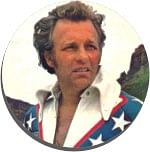 By Tareq Adnan
By Tareq Adnan
Stats:
Name: Robert Craig “Evel” Knievel Jr.
Birth Date: October 17, 1938
Occupation: Stuntman, Motorcycle Daredevil
Broken Bones: 40
Imagine yourself in a crowded arena, sixteen cars lined up in front of a ramp, you on a Harley and waiting for the signal. Then imagine yourself riding over the ramp, flying over the cars and then making a successful landing, the crowd going wild. Yeah, that would be the life eh? Evel Knievel was one of these people who lived that daredevil life, becoming immortal as the man who enticed a nation with his antics and stunts.
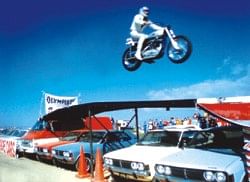 Born in Butte Montana to Robert and Ann Knievel, Evel was raised by his grandparents after his parents divorce. He dropped out of high school and got a job in a mining company, from which he was promptly fired after making an earth mover do a wheelie and crash into the city's main electrical lines. Out of a job he turned to crime, mainly burglary.
Born in Butte Montana to Robert and Ann Knievel, Evel was raised by his grandparents after his parents divorce. He dropped out of high school and got a job in a mining company, from which he was promptly fired after making an earth mover do a wheelie and crash into the city's main electrical lines. Out of a job he turned to crime, mainly burglary.
Throughout his teenage years and mid twenties Knievel kept going in and out of jobs, ranging from being the owner of a hockey team to an insurance salesmen. After trying and failing Evel decided to turn stuntman, inspired by the Joie Chitwood (another stunt artist) stunt show he had once seen in his child hood. But after his first independent show, in which he jumped over a tank of rattlesnakes and a cage with mountain lions, Knievel realized he needed to hire more artist and better organizers than himself, to do that he needed a sponsor, which he found in the form of Bob Blare. After that he started his crew, Evel Knievel and his Motorcycle Daredevils. His first show was a huge success and as his fame grew, so did the outrageousness of his stunts. At some point he started jumping cars, from which he advanced to trucks and buses. Not happy with the money earned from the stunts Knievel started a marketing empire selling Evel Knievel action figures and even a pinball machine.
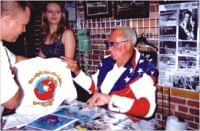 Among his more famous stunts was his jump over the fountains at Caesar's Palace, a casino in Las Vegas. While going up the ramp his motorcycle unexpectedly slowed down and land short on the safety ramp. He suffered a crushed pelvis and hip, broken wrists and ankles and a concussion that caused a 29 day coma. Then there was the Snake River Canyon jump, which he did after the US government denied him the right to jump the Grand Canyon. The drogue parachute on the X-2 Skycycle deployed early and Knievel couldn't make the jump. He landed in the Canyon with only minor injuries.
Among his more famous stunts was his jump over the fountains at Caesar's Palace, a casino in Las Vegas. While going up the ramp his motorcycle unexpectedly slowed down and land short on the safety ramp. He suffered a crushed pelvis and hip, broken wrists and ankles and a concussion that caused a 29 day coma. Then there was the Snake River Canyon jump, which he did after the US government denied him the right to jump the Grand Canyon. The drogue parachute on the X-2 Skycycle deployed early and Knievel couldn't make the jump. He landed in the Canyon with only minor injuries.
After retiring twice and declaring bankruptcy and getting inducted into the Motorcycle Hall of Fame, Knievel now lives a quiet life.

Minimum System Requirements
System: Intel Pentium IV 2.0 GHz or equivalent
RAM: 1024 MB
Video Memory: 256 MB
Hard Drive Space: 7000 MB
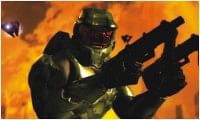 Halo 2 was released on the Xbox back in 2004, and as you're probably aware of by now, it was a huge success. Three years later, it's now available as one of the first Vista-only PC games. It's still easy to see why this game was so loved on consoles in its day, but when you put it in direct comparison with recent PC shooters, it loses a ton of its appeal, making it best suited for Halo fans who want a good way to play or make custom maps.
Halo 2 was released on the Xbox back in 2004, and as you're probably aware of by now, it was a huge success. Three years later, it's now available as one of the first Vista-only PC games. It's still easy to see why this game was so loved on consoles in its day, but when you put it in direct comparison with recent PC shooters, it loses a ton of its appeal, making it best suited for Halo fans who want a good way to play or make custom maps.
The single-player campaign in Halo 2 isn't particularly lengthy, and it should take the average player 10 hours or less to crawl through on its default difficulty setting. The story starts you out as the Master Chief, the intrepid space 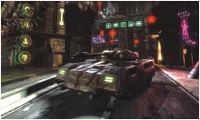 marine that blew apart the Halo ring, a devastating galaxy-destroying weapon, in the first game. The plot of the second game deals with the Covenant attempting to go on this great journey using another Halo ring, called Delta Halo. But there's plenty of political upheaval going on in the Covenant ranks, making it tricky all around. Add in a Covenant invasion of Earth, and you've got all the pieces required to throw these factions together again for another round of fighting. With some good vehicle sequences to break up the first-person action, but it's also one that feels like it could have been a lot better.
marine that blew apart the Halo ring, a devastating galaxy-destroying weapon, in the first game. The plot of the second game deals with the Covenant attempting to go on this great journey using another Halo ring, called Delta Halo. But there's plenty of political upheaval going on in the Covenant ranks, making it tricky all around. Add in a Covenant invasion of Earth, and you've got all the pieces required to throw these factions together again for another round of fighting. With some good vehicle sequences to break up the first-person action, but it's also one that feels like it could have been a lot better.
The multiplayer side of Halo 2 is the part that still gets attention to this day, and it translates to the PC fairly directly. The game has support for 16 players. Halo's multiplayer moves relatively slow when compared to other popular shooters, giving it a more methodical, tactical feel. You really need to know the capabilities of all your weapons to succeed with any regularity, as at any moment you'll be able to toss grenades or close in for a melee attack.
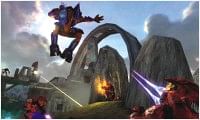 There are plenty of game types built into Halo 2, and these games work on any of the 23 included maps. Aside from standard deathmatch, called slayer here, most of the modes are team games, like capture the flag, team slayer, and so on. There are also a ton of built-in variants for the modes, such as team shottysnipers, which arms every player with a shotgun and a sniper rifle and removes all the other weapons on the map
There are plenty of game types built into Halo 2, and these games work on any of the 23 included maps. Aside from standard deathmatch, called slayer here, most of the modes are team games, like capture the flag, team slayer, and so on. There are also a ton of built-in variants for the modes, such as team shottysnipers, which arms every player with a shotgun and a sniper rifle and removes all the other weapons on the map
Halo 2 is the first game out there with support for the PC version of Xbox Live, the console's pay-to-play online service.
The visuals in Halo 2 aren't going to win any awards. Yes, it certainly looks better than its Xbox counterpart, but that's mostly due to antialiasing and support for resolutions up to 1680x1050. On a fairly modern machine that bypasses the minimum requirements, things like fog in the single-player will have a pretty heavy impact on the frame rate.
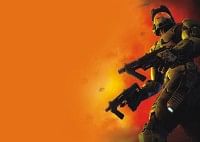 The early battles on Earth look nice, and your time spent on alien ships and worlds reveals a great attention to detail, making each environment look like a cohesive part of a sci-fi universe and not just a thrown-together clump of vaguely futuristic textures. The sound effects also do a good job of driving this point home, with plenty of good ambient sounds and quality weapon noises.
The early battles on Earth look nice, and your time spent on alien ships and worlds reveals a great attention to detail, making each environment look like a cohesive part of a sci-fi universe and not just a thrown-together clump of vaguely futuristic textures. The sound effects also do a good job of driving this point home, with plenty of good ambient sounds and quality weapon noises.
The single-player campaign is interesting, and the cliff-hanger doesn't feel so horrific when you consider that Halo 3 is going to be hitting consoles to finish the story in just a few months. The multiplayer side is fun, too, but all of it feels overshadowed. The PC has more than its fair share of amazing shooters that blow Halo 2 away in every possible way, making this one best suited for Halo fans that want an easy way to play custom maps. However, even those fans are just as likely to be put off by the imbalance between the game's two controller options, making it a bit of a no-win situation, despite its high production quality.

By Gokhra and Mood Dude
Mood Dude (DM): Bikes are awesome. They are open, sleek, fast and can get you to places with the minimum of fuss. It is the ultimate expression of freedom of movement.
Gokhra (G): Definitely, it is more like freedom of movement from this world to the next. Usually the exit is headfirst. With bugs in the teeth. And then teeth are gone.
(DM): Ok, ok, point taken. But despite all that and maybe in spite of all that, bikes are the epitome of cool. So what happens when you get the same thrill but with minimum fuss?
(G): Like with training wheels on the back? What you see in the pics look like a with the unholy DNA of a bike embedded deep in its soul.
(DM): The X-Bow concept is the first car ever built by KTM, Europe's second-largest motorcycle maker. The X-Bow's motorcycle roots are evident in its barebones open construction, which features a carbon-fiber chassis more like an open-wheeled Formula car than a conventional roadster.
(G): As such, it does away with many conventional automotive amenities like a sound system and air conditioning.
(DM): The juice on offer is from an Audi powerplant. KTM teamed up with Audi to develop the 2.0-liter direct-injection turbocharged 4-cylinder engine which produces 220 bhp. A high-output version of 300 bhp is contemplated. Now imagine bike performance but with the stability of four wheels planted on the ground.
(G): The X-Bow is also equipped with a 6-speed manual gearbox. A Dual Shift Gate (DSG) sequential-shift gearbox featuring clutchless operation may be offered later as an option. The bike roots come in from all the design elements. Check out the floating looking body panels. They look like they will fly off at speed and take off the heads of pedestrians.
(DM): The body panels are made to replicate the fairings on the bikes. But the clincher is the incredible low weight. At just about 700 kg, the X-Bow is expected to be blindingly fast. The factory estimates 0-60 mph acceleration of less than 4 seconds. The 300bhp model should do it in about 2.7 seconds.
(G): This light weight allows KTM to dispense with such features as power steering; the lack of a windshield means no wipers and the elemental nature of the vehicle itself eliminates the need for electronic driving aids. Basically, before you can speed off and crash, you will die from smoke, insects splattering in your teeth and drowning in rain.
(DM): The design allows the car at 200kmph to have a downforce three times that of the best supercars. Designed as a high-performance piece of sporting equipment, the X-Bow has no doors and features seats fitted with 4-point harnessesthe use of these belts and the crash performance of the carbon-fiber chassis mean that airbags aren't necessary.
(G): The first cars are expected to go on sale in Europe late this year and a KTM-sponsored race series for the X-Bow is planned for 2008. Prices are still sketchy.

